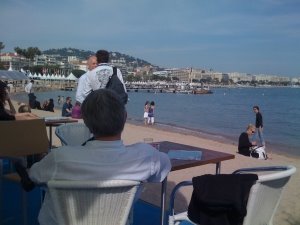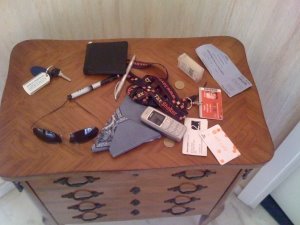 Back to selection
Back to selection
A TRIP TO THE CANNES FILM FESTIVAL’S ATELIER
Producer Noah Harlan posted earlier on this blog about his first few days in Cannes attending the Atelier with Jake Mahaffy’s Free in Deed, and his report below, cross-posted at his own 401st Blow blog, is a great intro to the world of co-production finance for U.S. indie producers. Read it and take notes.

I’ve been attending the Cannes Film Festival for nearly 10 years now (which, admittedly, makes me a Johnny-Come-Lately) and each experience of the week on the Croisette takes on it’s own qualities. Where you are staying, what you are trying to accomplish (premiering, selling, financing), the weather and a multitude of other factors come into play when evaluating the overall festival experience. But no single factor can change your experience more than the difference between attending the festival and participating in the festival.
When you have a film in the Official Selection the team at the festival are amazing and in the best possible way. Unlike festivals that are obsessed with social caché or media relations, Cannes is obsessed with its filmmakers and it treats them phenomenally well. Directors of selected films are invited, completely at festival expense, and are given ‘protocol’ representatives who will take care of any needs they have while they are there.
Tickets to a premiere? Done. Car to drive you somewhere? Done. Invitations to parties? Done. Press conference with a knowledgeable moderator? Of Course…
In 1998 the festival started the Cinéfondation to “inspire and support the next generation of international filmmakers.” The Cinéfondation is broken up into three parts: the Selection, the Residence and the Atelier.
The Selection comprises short films (this year 17), made by film students from around the world and which are screened in Cannes, as Official Selections, during the festival. These films compete for prizes that include roughly 35,000 Euros in cash and are judged by a serious jury, this year headed by John Boorman.
The Residence selects 6 filmmakers, twice a year, for a 4-1/2 month residency in a beautiful apartment in Paris where they are supported and mentored through the writing of a new project. The selected filmmakers have directed either shorts or, at most, one feature. The residency includes visits from acclaimed filmmakers (I’ve heard of people like Haneke just “popping in” to the apartment to chat) and each filmmaker is given an hour of Kodak stock towards their next feature. Additionally, once a year a filmmaker is awarded 20,000 Euro towards their film.
The Atelier started in 2005 and takes place for 8 days during Cannes. It is one of an emerging number of co-production markets taking place throughout the year. The Atelier selects 15 projects to participate and this year two of them were American: Jake Mahaffy’s FREE IN DEED (which I am producing) and Caran Hartsfield’s BURY ME STANDING (produced by the inimitable Effie Brown) – both Sundance Lab Projects. The Atelier sends out a booklet containing profiles of all the projects before Cannes to all the attendees and producers, financiers, distributors, broadcasters and sales companies are all invited to schedule meetings with the projects they are interested in. The Cinéfondation is overseen by Georges Goldenstern and the Atelier itself is run by Agnès Durvin (with support from Charles and Claire).
The father of all co-production markets is Rotterdam’s CineMart, a grueling (and thrilling) 4-1/2 days of meetings (upwards of 60-70) in half-hour increments. The Atelier is a little more relaxed given the greater time it has to run. Other co-pro markets include the Berlinale Co-Production Market, Tribeca All Access, Strategic Partners and IFP’s No Borders (and many others). Each has its own qualities and strengths but all can be useful ways to debut a project, meet potential partners and start (or continue) building your team.
As an independent producer in Cannes you are used to doing the Cannes shuffle: traipsing up and down the Croisette from meeting to meeting – now at the Grand Terrace, then to the Palais, then in the Miramar, then back to the Majestic Bar, etc… This is an exhausting process and as the sun gets hotter you become increasingly worn out. Each meeting involves taking a moment outside the door to some company’s office to collect yourself so you seem fresh, and clear, and then going into pitch mode. The primary activity of most companies at Cannes is buying and selling finished films in the market (if you’ve never been, think: AFM). This means that many people have relatively little bandwidth to discuss future projects and so you have to make the most of the limited attention you can claim from acquisitions execs and sales agents between screenings.
Being in the Atelier changes that experience. The Atelier provides a place – a terrace with tables, refreshments and a catered lunch – where you and your director host meetings. The execs meeting with you, have come because they know about the project and THEY have asked for the meeting. It creates a more comfortable environment and changes the dynamic somewhat. The basic “why are you here” is gone and instead it is replaced with a bit of “so the festival thinks you’re interesting, tell me more.” And that’s a better position to be in. In addition, the staff of the Atelier help to track down people you want to meet, they find tickets to screenings (Jake was handed orchestra tickets to that night’s competition premiere when he arrived – that’s pretty sweet). All of this makes the whole experience wildly different and far less stressful. It’s amazing what a little palm leaf in the corner of your script does…
Attending an international co-production market with an American project is a tricky prospect. There exists a form of Chinese Wall at the border of the United States and the definition of “co-production” is wildly different on either side. For us in the US, coproduction can mean any time two producers say to each other “hey, let’s work together.” They are, by colloquial definition, co-producing at that point. In Europe (in most of the world except the US), the local governments have proscribed a set of rules that define co-producing in a way that will best protect both their national cultural interests and their national financial interests. French films should be French. Israeli films should be Israeli and so on. To this end, they set up, often elaborate, sets of tax incentives, funds, and benefits for local production.
In order to facilitate making these films the various governments have signed treaties with each other to allow elements to be, in essence, ‘shared’. This means that if France and Israel have a bilateral coproduction treaty and a project has producers in both countries then any French element will be considered Israeli for qualifying in Israel and vice versa. This allows those producers to then access government film funds and tax investment funds and allows distributors and TV Channels in each country to do the same (which makes it easier for them to buy your film). In addition to bilateral treaties, some regions have governing conventions – for example Europe – where all the countries have a collective treaty. There are even specific organizations (Europe’s MEDIA, for example) that exist to support only projects that will broadcast in at least three different countries.
 At first glance, this system seems like a panacea for the average producer trying to make strong, independent films. But then you reach the US border. There are NO, and I mean NO – NONE – ZIP – ZILCH – NADA, treaties with the US. This was done to defend against the global hegemony of Hollywood Cinema. Without supporting their local industries, many countries would not have much of a local cinema and the multiplexes would be dominated by Nora Ephron and Michael Bay. Unfortunately the rules don’t differentiate between “independent” US films and Hollywood so most foreign producers are simply not able to work with you. That also means that you are a harder acquisition for distributors and TV channels and thus, harder for Sales companies to bet on.
At first glance, this system seems like a panacea for the average producer trying to make strong, independent films. But then you reach the US border. There are NO, and I mean NO – NONE – ZIP – ZILCH – NADA, treaties with the US. This was done to defend against the global hegemony of Hollywood Cinema. Without supporting their local industries, many countries would not have much of a local cinema and the multiplexes would be dominated by Nora Ephron and Michael Bay. Unfortunately the rules don’t differentiate between “independent” US films and Hollywood so most foreign producers are simply not able to work with you. That also means that you are a harder acquisition for distributors and TV channels and thus, harder for Sales companies to bet on.
However, don’t lose hope! The flipside of all this is that English language films tend to sell better when they are made, they travel better and the audience will watch them. So that, at least, will keep the sales teams interested.
The way I like to run the pitch meeting is to, after the customary pleasantries, tell the person meeting with us what we’re going to do. This establishes the agenda and allows me to guide the conversation. I give them my card and a booklet we’ve made about the project. I will tell them about who I am, who Jake is and a tiny bit of background about the project and then I will have Jake tell them about the film. He describes the basic story (which they probably already know, but now he fleshes out more details), why he’s making the film, his approach to the material and anything else that fills out the picture of the project. Some execs will ask lots of questions, others will be rather quiet. My job is to cover any points in the pitch that Jake may have missed – you begin to forget what you’ve said after doing a dozen pitches in a day – and to answer technical questions about schedule, financing, or other matters.
You often get a quick sense as to whether someone is interested or not and if you wind up having a lively discussion about the ideas, themes or creative concepts of the project then you can feel pretty good. If they don’t ask questions then I tend to find they’re probably not that interested and you should let them out of the meeting gracefully. If they seem interested then we offer DVDs with samples of Jake’s work (or in some cases a full feature) and I offer to give them a hard copy of the script, mail them one or email them a PDF. 99% of the time they want the script emailed. Nobody wants to lug home 20 pounds of scripts, so don’t worry about too many copies. In all of Cannes this year I gave out a single hard copy.
In preparing for your meetings it’s important to do some basic due diligence to understand who you’re meeting with. Are they a sales company? If so, what are they selling? If you don’t know, ask. Even if you do know, ask. The best thing you can do is to understand a company’s editorial line. Everyone has SOME editorial line that guides their decisions. We met with one woman who is a consultant for a foreign sales company who, in so many words, told us that “you probably will get a big sales company but, if you don’t, we’d be interested”. So their editorial line is picking up the crumbs. Good to know, I’m probably not going to sign with them before the film is done, whereas I might sign with a bigger sales agent who focuses on films like ours earlier (think Fortissimo, Celluloid Dreams, Films Distribution, etc…).
For some foreign producers, they are trying to see if there is an angle to get involved given the limitations on American coproductions. For example, one producer from a former eastern bloc country told us he could bring 20% in local funding for post production services, particularly if we used local technicians, and then he told us we could probably fudge the books about the local technicians. He wasn’t joking – in fact he scared us a little when he declared, “You will come and work in [city name redacted for my safety], yes? I provide what I say, so you bring film.” Awkward, but perhaps useful someday.
 There was a company from England that met with us who sat down and explained that they were really into genre product (ie: commercial horror or comedy). We asked if they had read the synopsis of our film. They said no. We asked if they had seen the Atelier’s booklet. They said no. Apparently, they heard there were films taking meetings and they just signed up. That meeting was a waste of everyone’s time.
There was a company from England that met with us who sat down and explained that they were really into genre product (ie: commercial horror or comedy). We asked if they had read the synopsis of our film. They said no. We asked if they had seen the Atelier’s booklet. They said no. Apparently, they heard there were films taking meetings and they just signed up. That meeting was a waste of everyone’s time.
There were several producers from France & Germany who met with us thinking they could find an angle to participate in an American film but I know they can’t. In some cases, the producers don’t even realize that they can’t participate. I had to explain to a couple why they couldn’t work on our film. Some would swear that we could make our film with Arté, but I have spoken with Michel Reilhac (head of Arté France Cinema) and he has told me personally he can’t come on board since his money is all French state money. I would have to explain this to these producers. We had a great meeting with Jörg Schneider from Das kleine Fernsehspiel in Germany who loved the project and felt it was exactly what he was looking for, however he can ONLY invest in first or second features. We all pondered for a few minutes if Jake’s experimental first feature, WAR, could be considered an art piece instead of a feature but, having premiered at Sundance, we realized there was nothing to be done.
The dance of co-production rules is frustrating and I actually know of one US producer who just flat out said to a French producer at the start of a meeting “we can’t work with you.”
Blunt. But True.
In looking back at the 55 or 60 meetings of the past week I feel that the most productive were likely with International Sales agents and with producers in the UK, Russia and Korea where the investment criteria is more liberal and they can, occasionally, participate in a US film.
So, where do we find ourselves? We’ll know more in a couple weeks after people have read the script and watched Jake’s films. Often the meetings you are taking in a co-production market are really laying the groundwork for deals that may not materialize until the film is shot but that doesn’t mean the experience was fruitless. Also, the credibility of having Cannes’ stamp on the project while it is still in development has tangible value. This year there were (I believe) six films in various parts of the festival that were from the Atelier and the Atelier as a whole has an 80% success rate in getting films financed.
I only hope the last 20% aren’t all the American projects…
Note: So Yong Kim’s TREELESS MOUNTAIN was in the Atelier as was Braden King who is shooting his feature HERE in the next few weeks, so it can be done. — Noah Harlan
Photo captions: The Official Selection red carpet as seen from the top of the Palais on the Festival Terrace (top); The view from one of the national pavilions on the beach (middle); Cannes Necessities: keys, wallet, pen, sunglasses, badge, biz cards, wifi access card, french cell phone, handkerchief, premiere ticket & tea tree sticks (optional, but nice for a minty-fresh mouth) (bottom).
